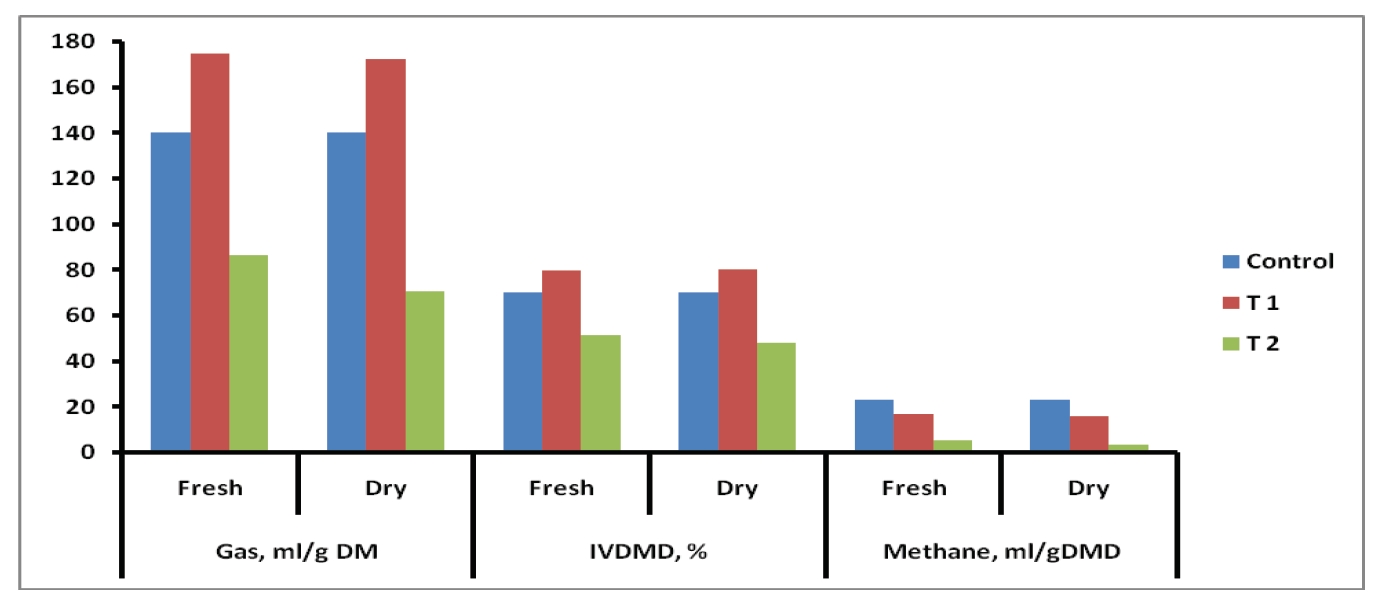Modulating feed digestion and methane production by eucalyptus (Eucalyptus citriodora) leaves essential oils in water buffalo (Bubalus bubalis)
DOI:
https://doi.org/10.56825/bufbu.2022.4113155Keywords:
Bubalus bubalis, buffaloes, eucalyptus leaves, essential oils, methanogenesis, rumen fermentationAbstract
Farm ruminants are responsible for about 15% of total global methane emission due to enteric fermentation of feeds. Additives are being used to modify rumen fermentation towards reduced methanogenesis, however, hazards associated with feeding of antibiotics and other chemical compounds to livestock for improving animal performance and methane mitigation are growing public awareness and encourage the research towards exploiting natural products as feed additives. Therefore, an experiment was carried out to examine the potential of eucalyptus (Eucalyptus citriodora) leaves essential oils in modulating rumen fermentation for reduced methane production in water buffalo (Bubalus bubalis). Essential oils were extracted both from dried and fresh eucalyptus leaves, separately in Soxhlet’s apparatus by organic solvent, hexane [15 g leaves extracted in 100 ml n-hexane (mol. wt. 86.18, assay 99.0% and density 0.658)] for 72 h and tested at three dose levels (0, 0.5 and 2.0 ml) in buffered rumen fluid (BRF). Oats hay (200±5 mg) was used as substrate and incubated with 30 ml BRF in 100 ml calibrated glass syringes at 39oC for 24 h following standard in vitro gas production protocol. Gas production was recorded by displacement of piston in the syringe. Methane in the gas phase and volatile fatty acids in the fermentation medium were estimated by Gas Chromatograph (GC). The total gas production and dry matter digestibility was increased (P<0.05) at low dose (0.5 ml) of eucalyptus leaves extract, irrespective of nature of leaves however, these were reduced (P<0.05) at higher dose (2.0 ml). Methane production was reduced (P<0.05), irrespective of doses. Volatile fatty acids (VFA) production were increased (P<0.05) at low dose but higher dose detrimentally reduced it. Rumen ammonia - N was not affected at low dose however, it was reduced at high dose of extract. Extracts from both dried and fresh leaves behaved similarly in modulating all the rumen fermentation parameters at corresponding dose levels. Results of this study revealed reduced methane production with increased feed digestibility and volatile fatty acids production by dosing extract of eucalyptus leaves. Therefore, it suggests using of either extract of eucalyptus (Eucalyptus citriodora) leaves (0.5 ml/ 30 ml rumen fluid) or its corresponding dose of leaves as feed additive in buffaloes.
Downloads
Metrics
References
Benchaar, C., S. Calsamiglia, A.V. Chaves, G.R. Fraser, D. Colombatto, T.A. McAllister and K.A. Beauchemin. 2008. A review of plant-derived essential oils in ruminant nutrition and production. Anim. Feed Sci. Tech., 145(1-4): 209-228. DOI: 10.1016/j.anifeedsci.2007.04.014
Burt, S. 2004. Essential oils: Their antibacterial properties and potential applications in foods-A review. Int. J. Food Microbiol., 94(3): 223-253. DOI: 10.1016/j.ijfoodmicro.2004.03.022
Busquet, M., S. Calsamiglia, A. Ferret and C. Kamel. 2006. Plant extracts affect in vitro rumen microbial fermentation. J. Dairy Sci., 89(2): 761-771. DOI: 10.3168/jds.S0022-0302(06)72137-3
Calsamiglia, S., M. Busquet, P. Cardozo, L. Castillejos and A. Ferret. 2007. Invited review: Essential oils as modifiers of rumen microbial fermentation. J. Dairy Sci., 90(6): 2580-2595. DOI: 10.3168/jds.2006-644
Castillejos, L., S. Calsamiglia and A. Ferret. 2006. Effect of essential oil active compounds on rumen microbial fermentation and nutrient flow in in vitro systems. J. Dairy Sci., 89(7): 2649-2658.
Conway, E.J. 1962. Micro-Diffusion Analysis and Volumetric Error, 5th ed. Crossby Lockwood and Sons Ltd., London. UK.
Cottyn, B.G. and C.V. Boucque. 1968. Rapid method for the gas-chromatographic determination of volatile fatty acids in rumen fluid. J. Agric. Food Chem., 16(1): 105-107. DOI: 10.1021/jf60155a002
Dey, A., S.S. Paul, S.S. Dahiya and B.S. Punia. 2016. Garlic oil supplementation: effects on in vitro methanogenesis, rumen fermentation and gas production in buffaloes. In Proceeding International Livestock Conference and Expo (INDIGENOUS) and 23rd Annual Convention, Indian Society of Animal Production and Management at Prof. Jayashankar Telangana State Agricultural University, Hyderabad, Telangana, India.
Evans, J.D. and S.A. Martin. 2000. Effects of thymol on ruminal microorganisms. Curr. Microbiol., 41(5): 336-340. DOI: 10.1007/s002840010145
FAO. 2010. Greenhouse gas emissions from the dairy sector. A Life Cycle Assessment, Food and Agriculture Organization, Rome, Italy.
Johnson, K.A. and D.E. Johnson. 1995. Methane emissions from cattle. J. Anim. Sci., 73(8): 2483-2492. DOI: 10.2527/1995.7382483x
Menke, K.H. and H. Steingass. 1988. Estimation of energetic feed value obtained from chemical analysis and in vitro gas production using rumen fluid. Anim. Res. Dev., 28: 7-55.
Patra, A.K. and J. Saxena. 2009. Dietary phytochemicals as rumen modifiers: A review of the effects on microbial populations. A. Van Leeuw. J. Microb., 96(4): 363-375. DOI: 10.1007/s10482-009-9364-1
Sallam, S.M.A., I.C.S. Bueno, P. Brigide, P.B. Godoy, D.M.S.S. Vitti and A.L. Abdalla. 2009. Efficacy of eucalyptus oil on in vitro ruminal fermentation and methane production. Options Méditerranéennes., 85(85): 267-272.
Sallam, S.M., I.C. Bueno, M.E. Nasser and A.L. Abdalla. 2010. Effect of eucalyptus (Eucalyptus citriodora) fresh or residue leaves on methane emission in vitro. Ital. J. Anim. Sci., 9(3): 299-303.
SPSS. 1996. Statistical Packages for Social Sciences Version 7.5. Statistical Packages for Social Sciences Inc., Illinois, USA.
Van Soest, P.V., J. Robertson and B. Lewis. 1991. Methods for dietary fiber, neutral detergent fiber, and nonstarch polysaccharides in relation to animal nutrition. J. Dairy Sci., 74(10): 3583-3597. DOI: 10.3168/jds.S0022-0302(91)78551-2









.png)








